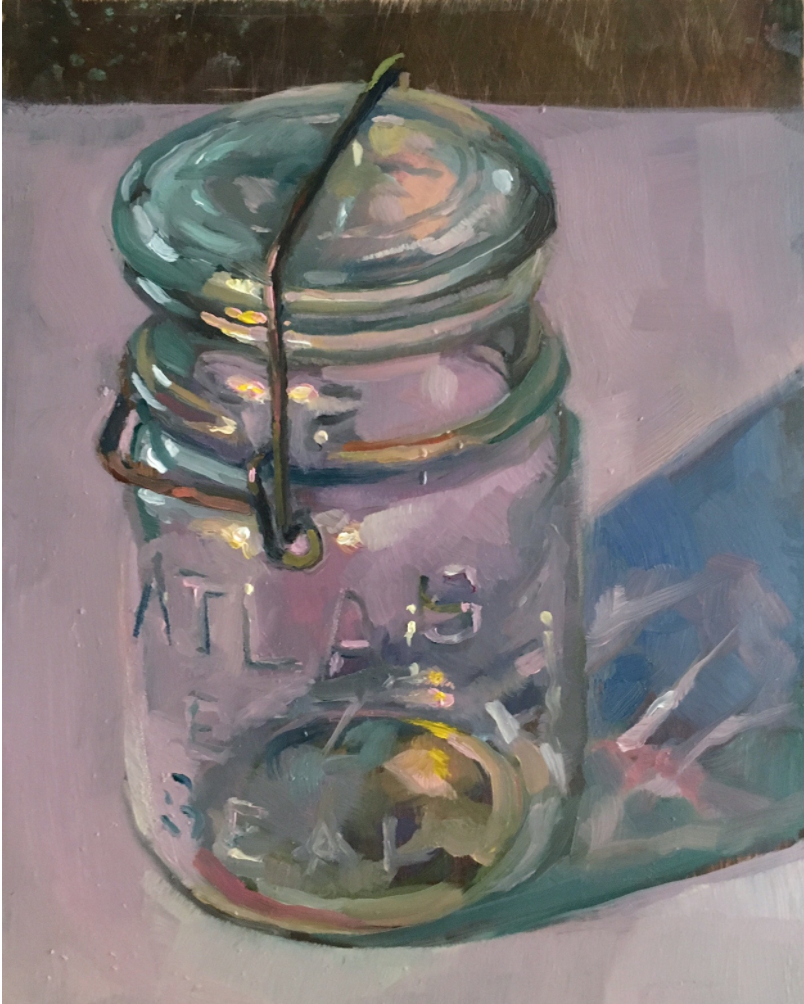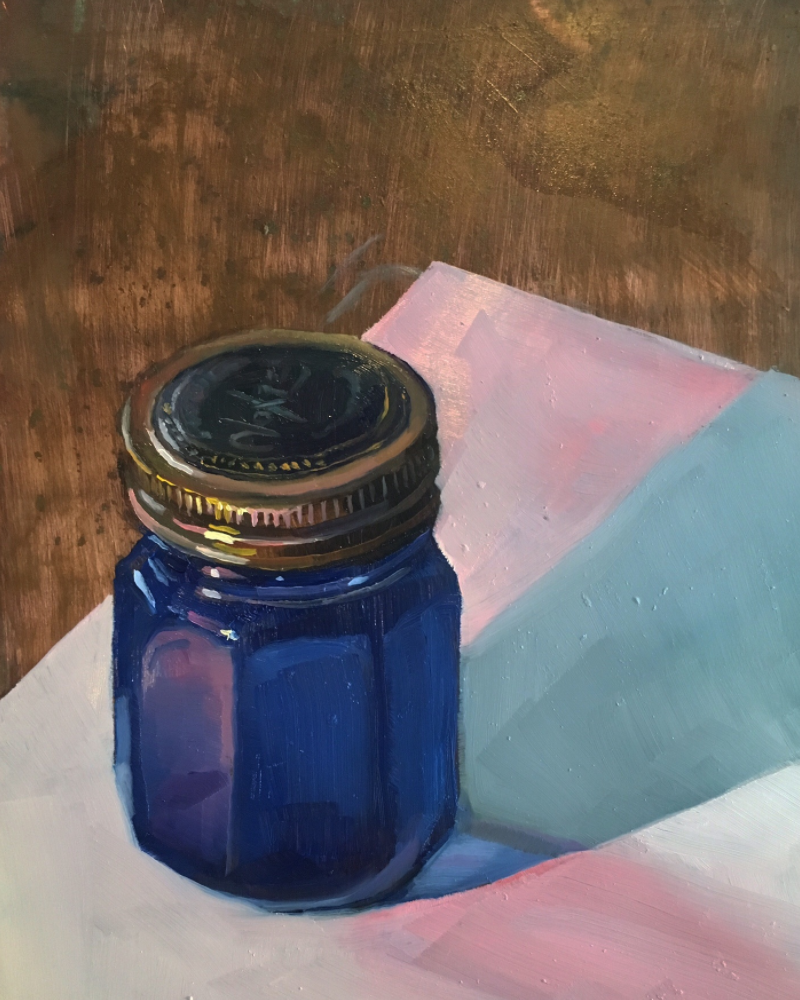Q&A: Carl Grauer
Carl Grauer’s Noxzema Jar (2017) has already been sold. I’d advise collectors to purchase his other still lifes while they still can. They’re mature, thoughtful, and very well painted. They’re also ever so slightly nostalgic… Grauer may be said to memorialise or musealise the present as it becomes the past. Impressively, this is achieved with such understatement that it belies the trope of musealisation itself.
‘Since the 1980s, it seems, the focus has shifted from present futures to present pasts,’[1] argues Andreas Huyssen. His Present Pasts (2013) focussed on the literary, cinematic, and monumental rather than such comparatively lowlier forms of artist expression as the still life. Nonetheless, it’s precisely this comparative lowliness or modesty that makes these paintings so convincing. It’s fitting that the still life remains perhaps the most traditional of the painter’s crafts.
Grauer’s still lifes suggest an imaginary museum commemorating our everyday bric-à-brac: old jars; perfume bottles; salt and pepper shakers; pliers; clips; even laptop chargers. In fact, the laptop charger is my favourite. Computers. It’s difficult to think of a more perfect example of the present becoming the past so quickly. There’s something especially collectible about these paintings. Perhaps, because the objects already seem to have been collected, curated, and arranged by the artist himself.
One final detail. Grauer’s still lifes are painted on copper. He always leaves a small part exposed. It catches the light just as these objects may have once caught the light. Nonetheless, there’s something tangibly treasurable about the gleam of metal lurking behind the oil paint. It makes these still lifes even more unique than they already are.
DG: “Carl, when did you start painting these still lifes?”
CG: “I’d been working on a previous series of greater size, mostly based on photos from earlier this year. But I reached a point where the work felt weighted and no longer relevant to me. I started to get stuck as painter.”
DG: “So it began with creative block?”
CG: “Yes.”
DG: “And what about the copper? It’s quite unusual compared to canvas or board.”
CG: “When visiting my father in Colorado, he had some left over old copper flashing and he kindly gifted to me as I thought it would make for an interesting surface to paint on. I’d been holding on to it for a year. So, for these little stills. I thought, why not use the copper? With each painting a small bit of the copper is left exposed as to offer a glimpse into this precious little moment. Also, the exposed copper will oxidise over time.”
DG: As if the painting was continuing to paint itself in the background?
CG: “Yes, the patina will be another testimony to the passing of time.”
DG: “It’s not just the copper that seems ‘precious’ about these still lifes. It’s almost as if each object has been re-evaluated by your discerning eye. As if they’re no longer simply everyday ‘things’ but important objects of a material culture?”
CG: “I’d always found these artefacts that are remnants of times forgotten or people passed extremely moving. I've often been interested in the concept of nostalgia having run a vintage furniture store. Interestingly, I was researching the concept of memory and nostalgia recently. I discovered that at one time during the 19th century, nostalgia was considered a mental illness that would lead to harmful depression. Now, we merely consider it a sad melancholic feeling, as if there was once a better time or that things were better in our past.”
DG: “I had the impression that the paintings were imbued with a tinge of melancholy. Especially the paintings with the pink hues that linger over your chosen objects. As if it’s late afternoon and the day is done?”
CG: “The pink hues are very intentional. I would typically paint the stills at the end of the day with the setting sun this past winter and early spring. The window is north-westerly facing to allow the warm light of the sunset to enter, and I really loved this cast of light.”
DG: “I’d also like to say that the objects you’ve chosen seem to be passing into history, turned over to memory, to the collector, the collection, and so on. Your stills of the old mason jars, cobalt blue bottles, even the laptop charger... I suspect they’ll appeal to the everyday collectors among us. How do you connect yourself to the past? Does the past, or the sense of the present becoming the past inform your art?
CG: “I often think of my place in time and of history. Our place in time and how we relate the ever-changing mind-sets from generation to generation. It fascinates me.”
DG: I wonder whether this is something that’s been carried over from your previous project, Recollections?
CG: “It was exactly that project that I was working on before I got stumped. I was spending so much time using photos as reference and consequently spending so much time in the past that I think I was getting a bit frustrated and less motivated to continue. At the onset of the series of Recollections about five years ago, my brother had passed away. It was quite a shock and on some level, I believe, I was returning to these images of our time as children to paint as a way to not forget him. It became this play with nostalgia, melancholy, love and mourning.”
DG: “It must have been quite difficult?”
CG: “Well, more recently I’d been painting from life through portrait sketches and commission based work. I was craving to be present and to paint more from my own life in the present. On some level, maybe time had healed some wounds… But perhaps these melancholic little still life paintings had a bit left over.”
DG: “I suppose still lifes can be somewhat meditative or cathartic in this sense?”
CG: “Yes. In order to keep painting, I began looking at the everyday objects that surrounded me. One by one I would set them down on an old matte board and would arrange simple settings to paint from life. It evolved into an everyday practice for a month.”
DG: “Carl, thank you for your time. I look forward to seeing more of your work.”
Carl Grauer will be exhibiting at The Other Art Fair in NYC on 1st - 4th June.
[1] Andreas Huyssen, Present Pasts, Urban Palimpsests and the Politics of Memory, (Stanford: Stanford University Press, 2003), p.11



